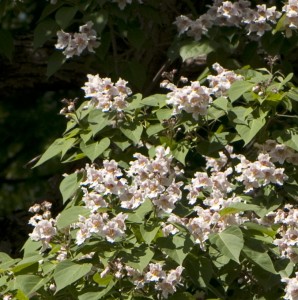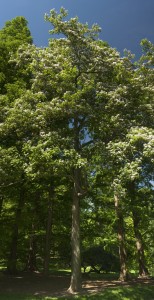Rarities: The Catalpa of Benenson
Posted in Around the Garden, Gardens and Collections on July 16 2012, by Matt Newman
 Back in the peaceful reaches of the Benenson Ornamental Conifers, there’s a question to be asked. Is there stock to be put in rarity, and does pairing that quality with beauty somehow amplify the “value” of what we’re looking at? I’m not about to try and delineate the boundaries of taste and worth; we work to preserve the future of plants, and that’s all there is to it. But there’s one species in mind that’s worth looking into.
Back in the peaceful reaches of the Benenson Ornamental Conifers, there’s a question to be asked. Is there stock to be put in rarity, and does pairing that quality with beauty somehow amplify the “value” of what we’re looking at? I’m not about to try and delineate the boundaries of taste and worth; we work to preserve the future of plants, and that’s all there is to it. But there’s one species in mind that’s worth looking into.
Catalpa fargesii manages that unique combination of scarcity and beauty. A Chinese native found in regions such as Guangxi, Hunan, and Sichuan, even in its homeland it’s considered extremely rare in the wild, only “discovered” by Western dendrologists early in the 20th century. In the Western world, where few specimens have propagated in Europe or North America, it’s rarer still. Here in the U.S., for example, there are only two recorded Chinese catalpa trees of this kind. The Arnold Arboretum at Harvard has one, accessioned in 1914; The New York Botanical Garden is home to the other. In this case, “exclusive” is not a word to be tossed around lightly.
 To understand how we came upon this uncommon specimen, we look back to 1936. Germany had only just violated the Treaty of Versailles, Spain was entering a civil war, and Italy was at odds with the French in North Africa. Europe, understandably, was thrumming with tension. But the state of world affairs hadn’t yet degraded to the point that daily business suffered at the Arboretum des Barres et Fruticetum Vilmorinianum in Nogent-sur-Vernisson, France. Horticulturists there had a scant handful of catalpa seeds for distribution, and the NYBG was on their mailing list.
To understand how we came upon this uncommon specimen, we look back to 1936. Germany had only just violated the Treaty of Versailles, Spain was entering a civil war, and Italy was at odds with the French in North Africa. Europe, understandably, was thrumming with tension. But the state of world affairs hadn’t yet degraded to the point that daily business suffered at the Arboretum des Barres et Fruticetum Vilmorinianum in Nogent-sur-Vernisson, France. Horticulturists there had a scant handful of catalpa seeds for distribution, and the NYBG was on their mailing list.
Of the six seeds that made the trip across the Atlantic, records show that only one of them came to fruition. But 76 years after its arrival, one proves enough. Our Chinese catalpa stands tall among the Benenson Ornamental Conifers, meeting each spring with a cloud of pale, exquisite flowers. Propagating the tree for the benefit of researchers and arboretums elsewhere in the U.S. has proven difficult, however. Maybe our catalpa is content to remain the rare breed that it is.
At 70 feet tall, this deciduous giant cuts a slim and striking figure, even among the behemoth conifers that surround it, though the catalpa is only one in a crowd of rarefied trees that lives in the arboretum. It’s a spot in our 250 acres that’s so often overlooked, tucked away in the northeast corner of the Garden between the Nolen Greenhouses for Living Collections and the Bronx River. Among the towering evergreens and the stone gazebos, you get the sense that maybe Benenson is best where it is, hidden in reserve for those of us who need a dose of silence in our day. At the very least, it’s keeping one valuable piece of Garden history safe for future generations.


….love this post because I missed the tree and can’t wait to go back and see it…as the tram winds thru, is it on side A or B?
thanks,
Barbara